~Affordable and Clean Energy: Why it Matters!~
Hello! I’m Keerthi, a 6th grade student at Freedom 7 Elementary.
Artist Statement(Goals):
My goal throughout these booklets was to convey and spread awareness about Sustainable Development Goal(SDG) 7, Affordable and Clean Energy. I decided to do it digitally on Canva, to make the finished product look neater with a good amount of reliable pictures and facts that thoroughly explain and spread awareness about using many different types of renewable energy sources, which don’t have negative effects on people’s well-being and the environment. I feel that I have achieved this goal, because my booklets have the right amount of information, without making it too wordy or hard to read. I also think I added the right amount of pictures to the booklet, that can pictorially represent, everything I talk about throughout the booklet. I also wanted to make sure the information on this website can be understandable to all. My goal while creating this essay, was to make an essay that is thoroughly filled with facts, statistics, and information that can convince someone to believe that SDG 7 is important, and using renewable energy sources, can reduce greenhouse gas emissions and impact people’s lives positively.
Introduction!
If you are able to conveniently use appliances found in your homes, you are lucky to have access to electricity!
SDG 7, Affordable and Clean Energy aims to provide high-quality electricity to the 789 million people who don’t have access to a cheap and reliable energy source.
An SDG is a Sustainable Development Goal created to solve global issues and make the world a better place to live in.
The SDGs were created by the United Nations in 2015. Before these goals were created in 2015, there were the Millennium Development Goals(MDGs).
The MDGs were created to tackle and solve major global issues, such as eradicating extreme hunger and poverty, improving maternal health, and reducing child mortality.
However, the MDGs were unsuccessful in achieving their goals, which is why the SDGs were created.
Providing affordable and clean energy access to everyone would help combat climate change and decrease the exposure to high levels of air pollution from relying on polluting fuels for cooking, transportation, and heating.
~Visual Arts!~
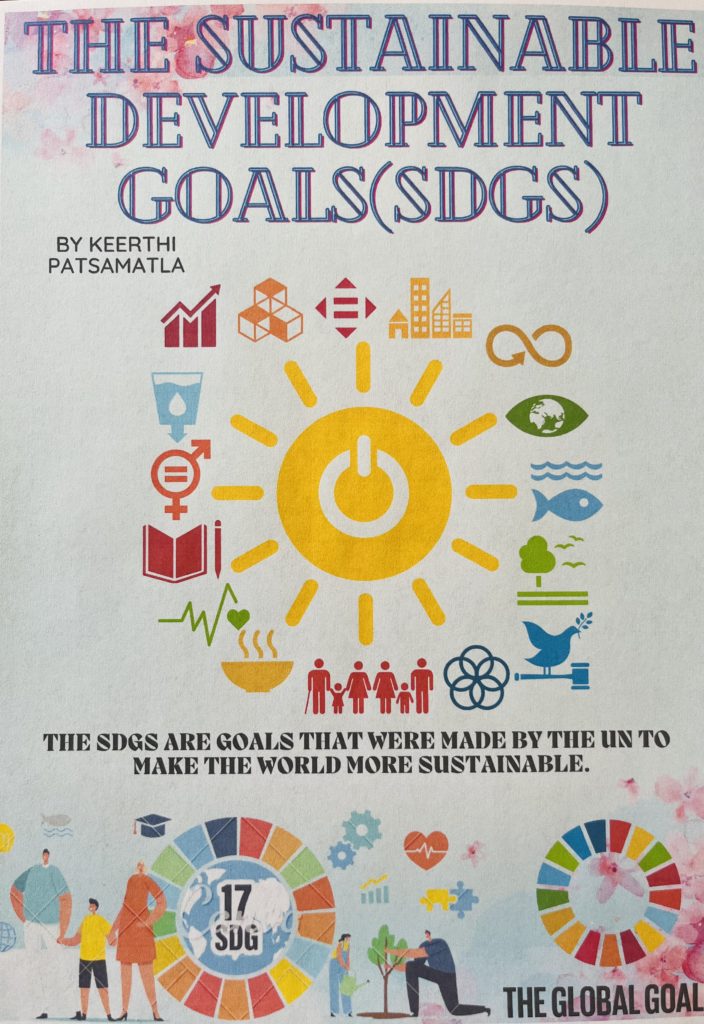
The Sustainable Development Goals are 17 super awesome goals designed to make the world a better place!
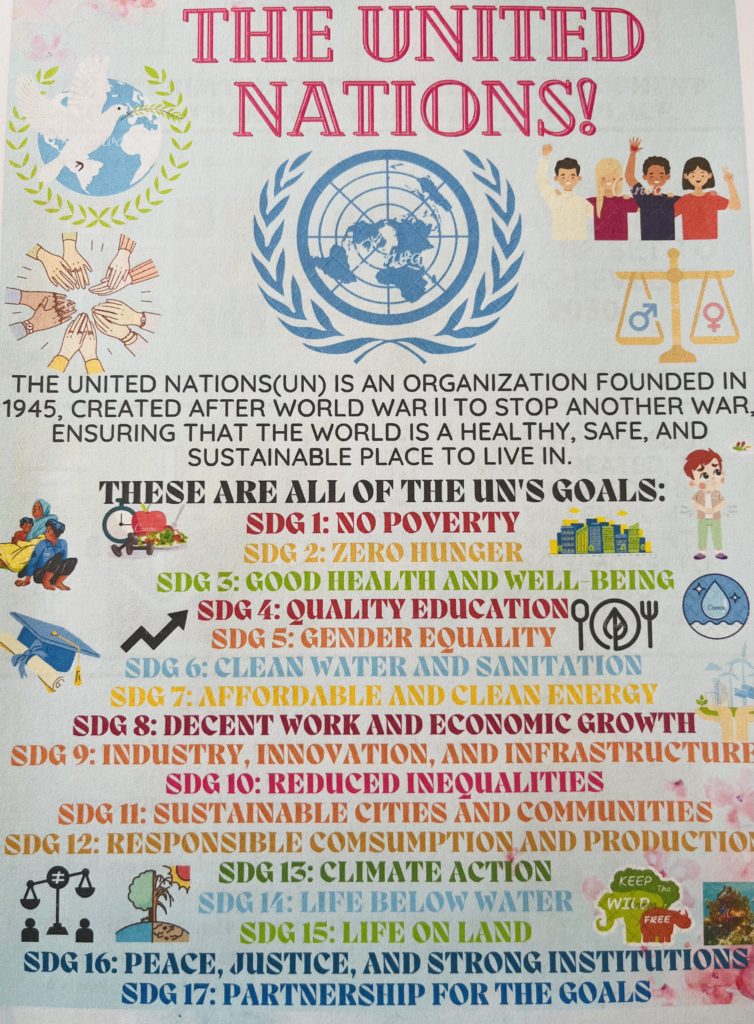
The United Nations is an international organization founded in 1945 after the Second World War by 51 countries committed to maintaining international peace and security, developing friendly relations among nations and promoting social progress, better living standards, and human rights.
There are also 8 MDGs created in 2000, before the SDGs were created!
MDG 1 – Eradicate extreme poverty and hunger
MDG 2 – Achieve universal primary education
MDG 3 – Promote gender equality and empower all women
MDG 4- Reduce child mortality
MDG 5- Improve maternal health
MDG 6 – Combat HIV/Aids, Malaria, and other diseases
MDG 7 – Environmental Sustainability
MDG 8 – Develop global partnership for development
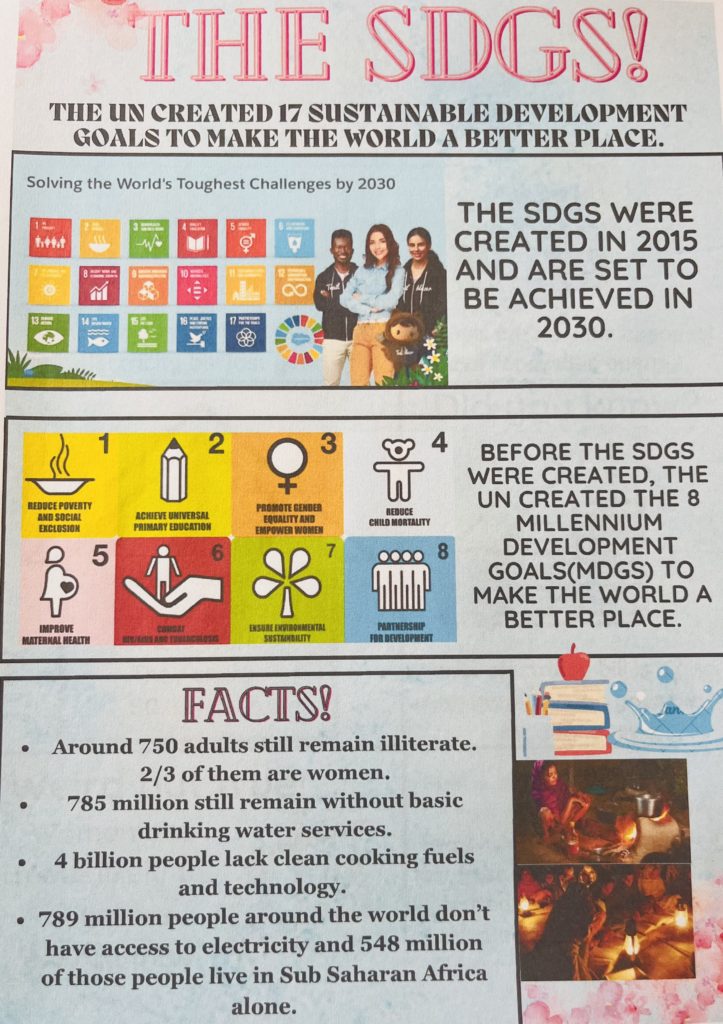
The SDGs were created in 2015, and hopefully be achieved by 2030. Each goal still has a LOT of progress to make, in order to be achieved by 2030.
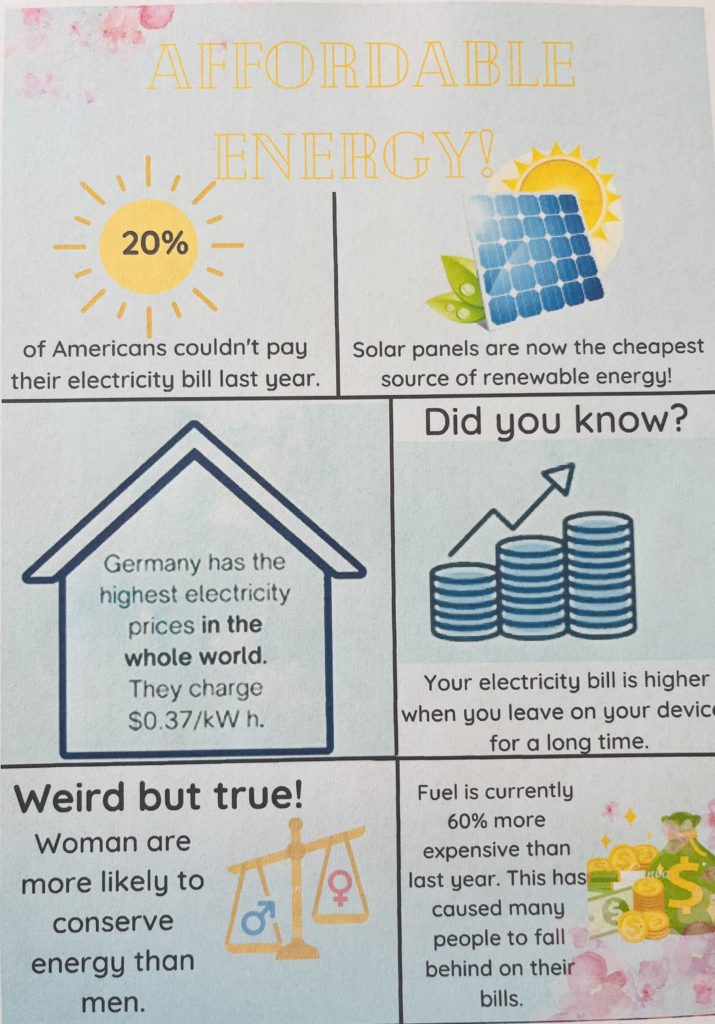
Using energy-efficient appliances such as LED light bulbs can save money, reduce the amount of greenhouse gas emissions into the atmosphere, and conserve energy for future generations to thrive!
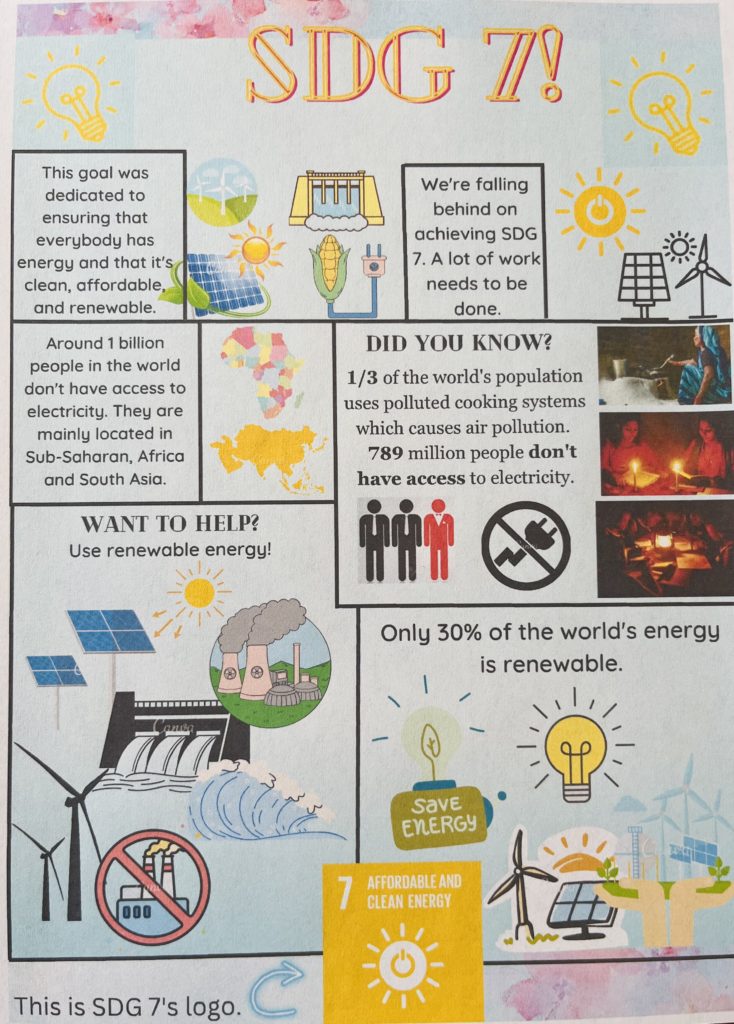
SDG # 7 is about ensuring access to clean and affordable energy, which is key to the development of agriculture, business, communications, education, healthcare and transportation. The lack of access to energy hinders economic and human development.
Why should you care about this goal:
- For many decades, fossil fuels such as coal, oil or gas have been major sources of electricity production, but burning carbon fuels produce large amounts of greenhouse gases, which cause climate change and have harmful impacts on people’s well-being and the environment.
SDG 7 Targets!
7.1 By 2030, ensure universal access to affordable, reliable and modern energy services
7.2 By 2030, increase substantially the share of renewable energy in the global energy mix
7.3 By 2030, double the global rate of improvement in energy efficiency
7.4A By 2030, enhance international cooperation to facilitate access to clean energy research and technology, including renewable energy, energy efficiency and advanced and cleaner fossil-fuel technology, and promote investment in energy infrastructure and clean energy technology
7.4B By 2030, expand infrastructure and upgrade technology for supplying modern and sustainable energy services for all in developing countries, in particular least developed countries, small island developing States, and land-locked developing countries, in accordance with their respective programmes of support.
Important Facts about SDG 7!
- 3 billion people rely on wood, coal, charcoal or animal waste for cooking and heating!
- Energy is the dominant contributor to climate change, accounting for around 60% of total global greenhouse gas emissions.
- Since 1990, global emissions of CO2 have increased by more than 46%.
- Hydropower is the largest single renewable electricity source today, providing 16% of world electricity at competitive prices. It dominates the electricity mix in several countries, developed, emerging or developing.
- Bioenergy is the single largest renewable energy source today, providing 10% of world primary energy supply.
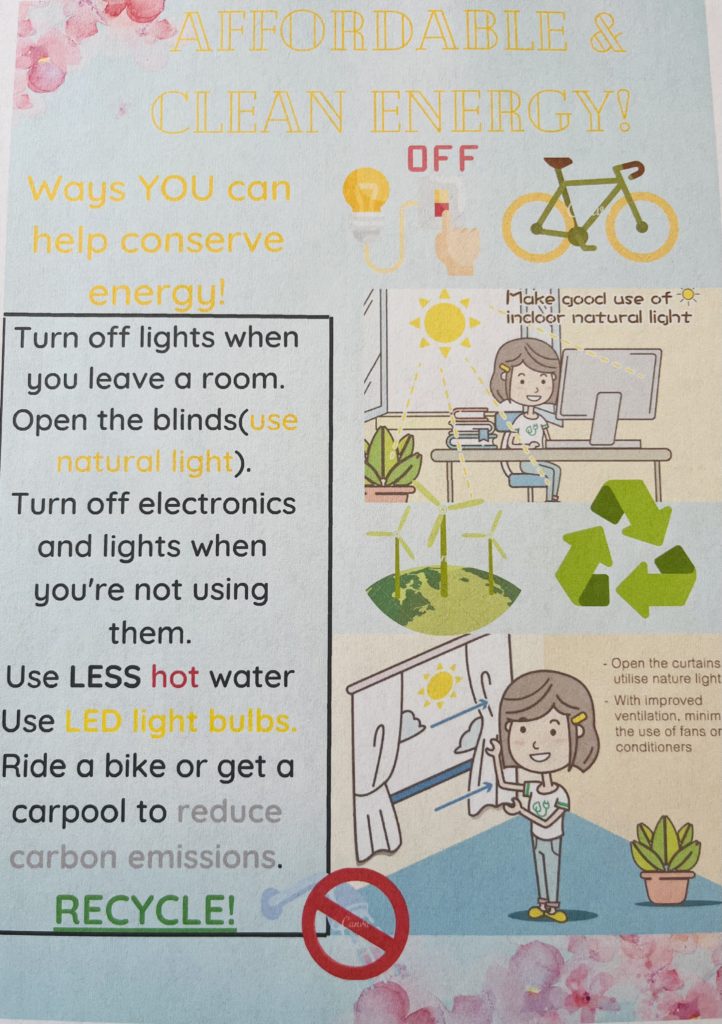
SDG 7 Ways to Take Action!
Countries can accelerate the transition to an affordable, reliable, and sustainable energy system by investing in renewable energy resources, prioritizing energy efficient practices, adopting clean energy technologies, and infrastructure.
Businesses can maintain and protect ecosystems to be able to use and further develop hydropower sources of electricity and bioenergy, and commit to sourcing 100% of operational electricity needs from renewable sources.
Employers can reduce the internal demand for transport by prioritizing telecommunications and incentivizing less energy intensive modes such as train travel and air travel.
Investors can invest more in sustainable energy services, bringing new technologies to the market quickly from a diverse supplier base.
You can save electricity by plugging appliances into a power strip and turning them off completely when not in use.
You can also bike, walk, and take public transportation to reduce carbon emissions.
~Close- Ups!~
Note: The close-up pictures were taken for the pages in the booklet that had some word(s) cut out/not captured in the image.
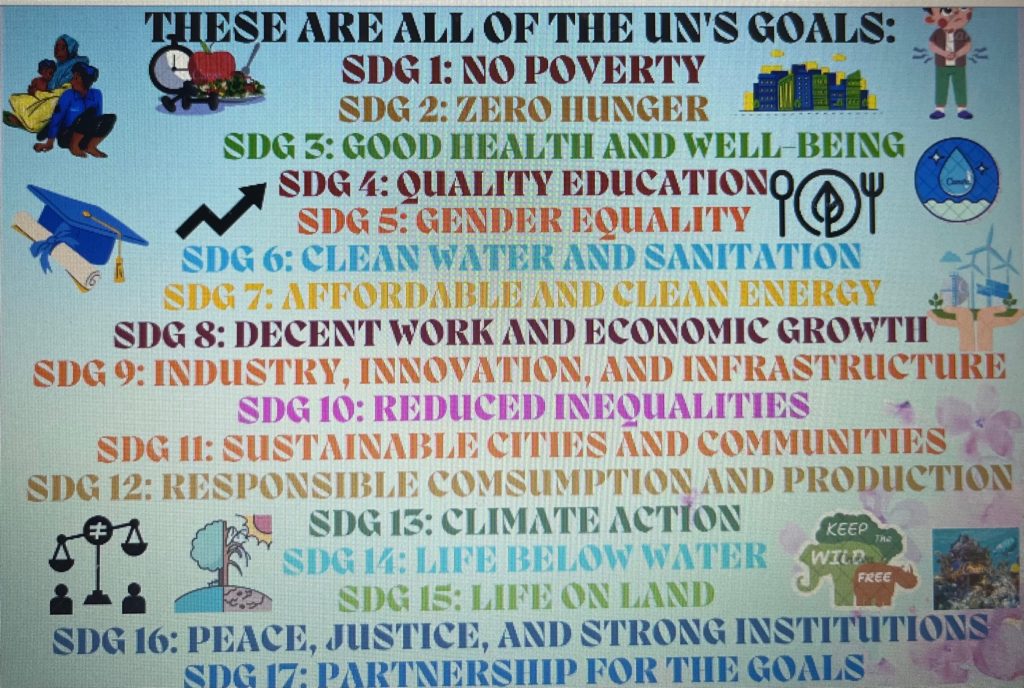
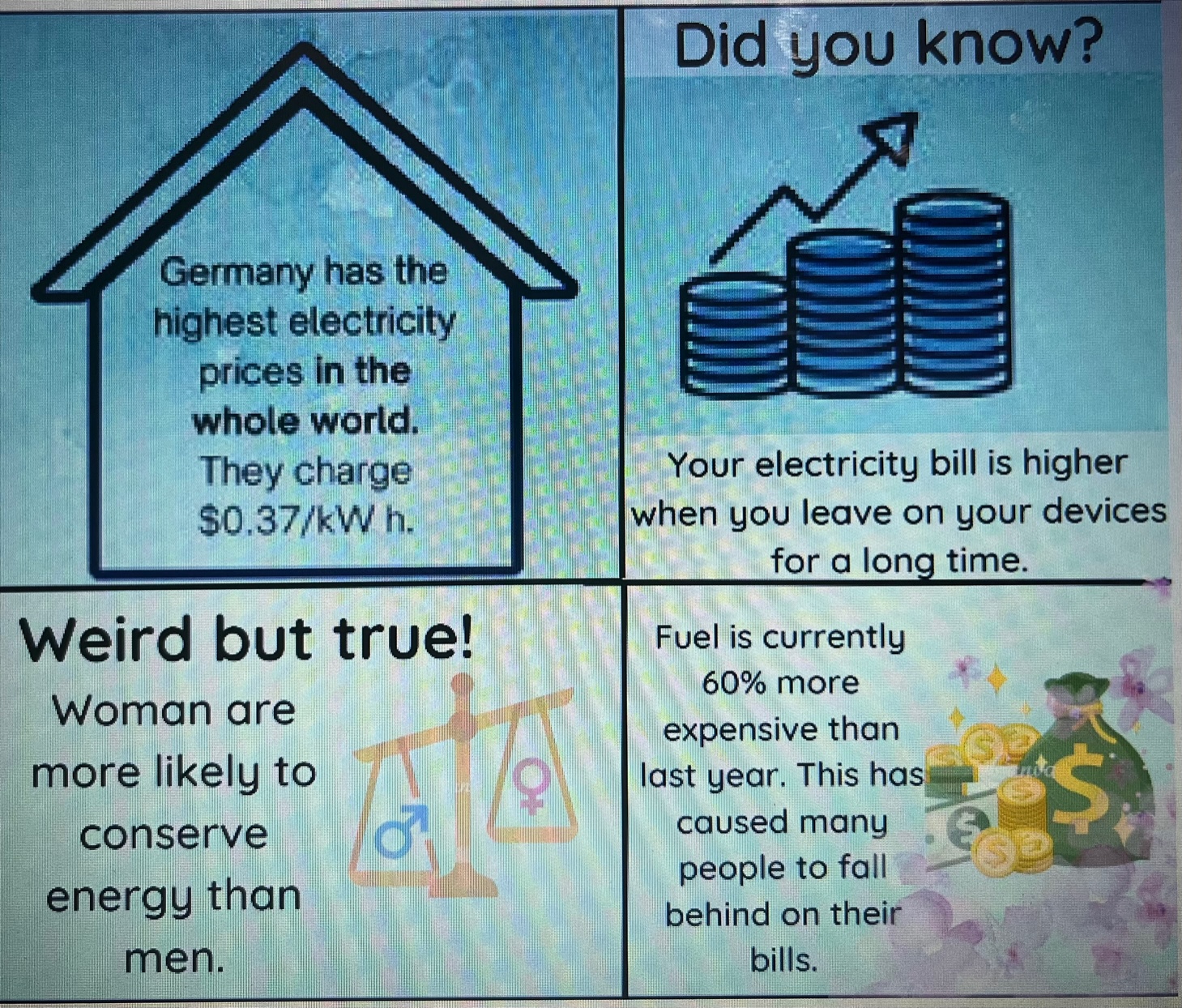
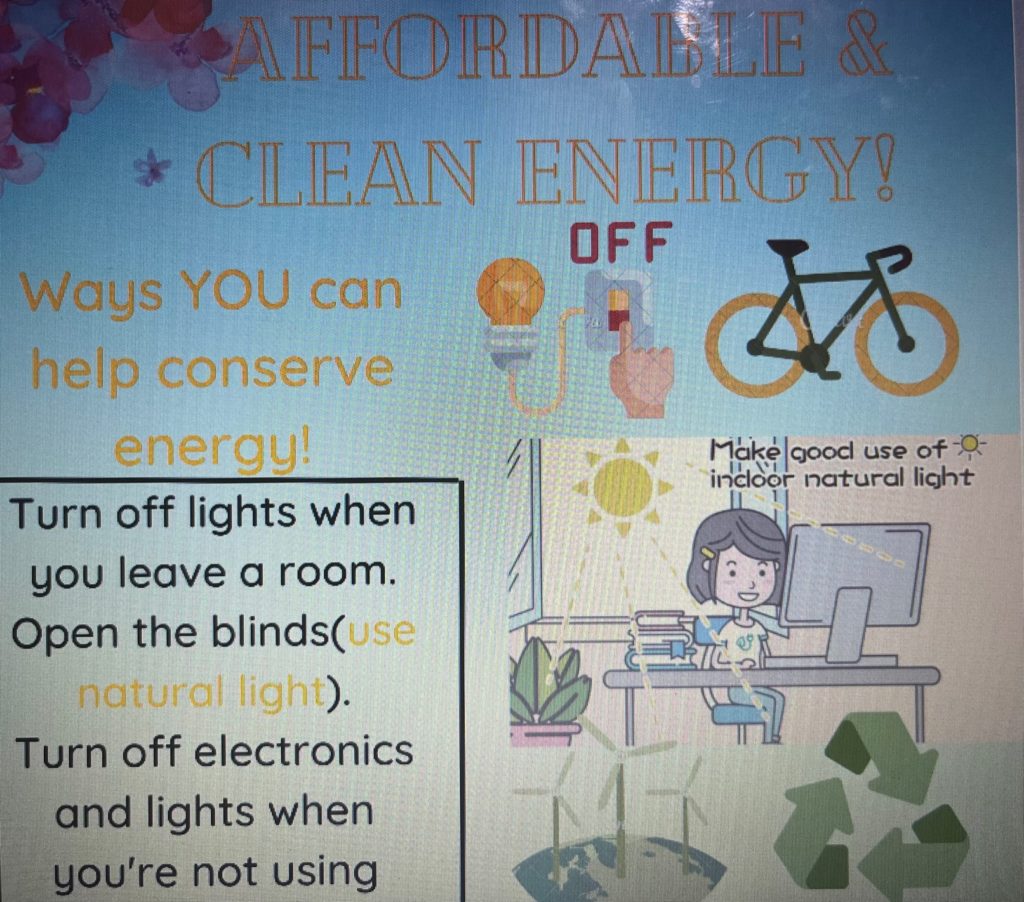
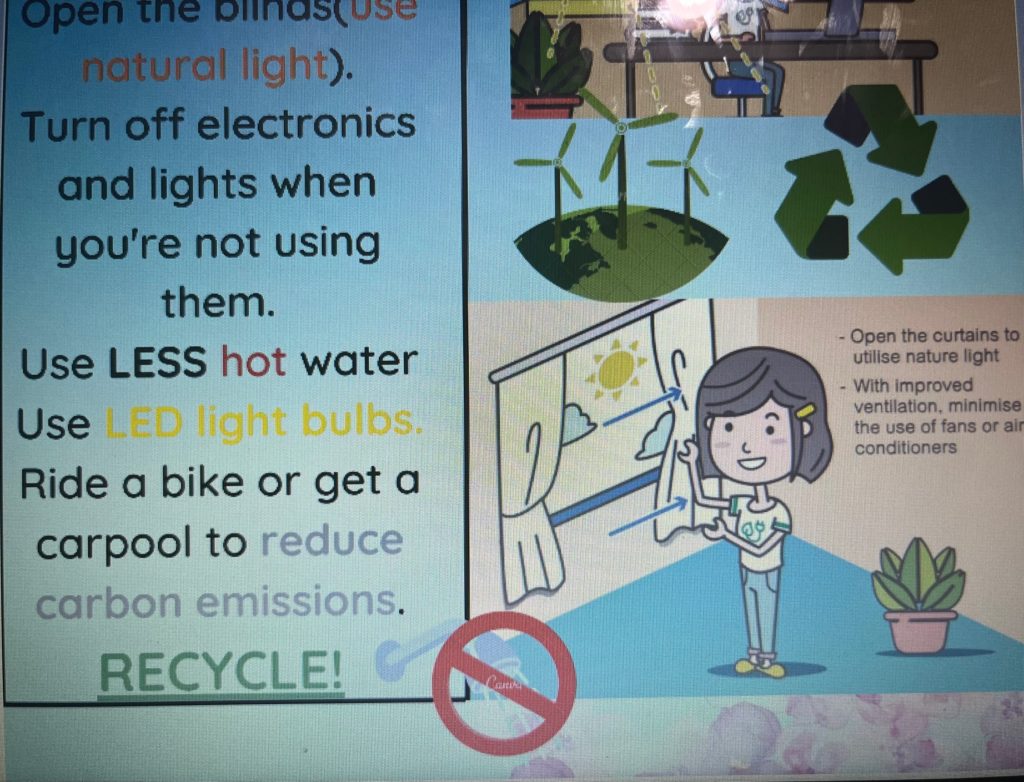
~Literacy Arts!~
Note: This essay was written to intensify my knowledge about using renewable energy sources such as solar, wind, and hydroelectric energy, which can help stop climate change, a major global issue. Also, the booklets, were an introduction to this essay. The booklets are brief about SDG 7 and using renewable energy, but does still provide a good amount of reliable facts, while the essay is more in-depth of SDG 7, Affordable and Clean Energy and using renewable energy sources.
An essay on the importance of SDG 7, Affordable and Clean Energy and using renewable sources of energy!
Things to know before reading this essay:
- The central idea and 3 LOIs(Lines of Inquiry) were the foundations, of what I was interested in researching and learning more about.
The amazing Sustainable Development Goal, Affordable and Clean Energy that aims to provide high-quality electricity to the 789 million people around the world who don’t have access to it! Many times we wonder if everyone in the world has access to electricity, but unfortunately, not everyone does. Research from the United Nations, has shown that nearly 789 million people around the world don’t have access to electricity, and 548 million of those people live in Sub-Saharan Africa alone. Electricity is a necessity in our daily lives, without it, life would be extremely difficult. For example, electricity is important for operating all appliances, entertainment, lighting, and technology. Also, without electricity, hospitals and medicine would not be able to be advanced and cure illnesses. One major problem we are currently facing around the world is that 789 million people don’t have access to electricity and 4 million people rely on polluted cooking fuels and technologies. This was why the United Nations(UN) created the Millennium Development Goals(MDGs) and Sustainable Development Goals(SDGs). The UN is an organization founded in 1945, created after World War Ⅱ to stop another war, ensuring that the world is a healthy, safe, and sustainable place to live in. The MDGs were created because the UN wanted to tackle and solve problems related to poverty, hunger, education, equality, maternal health, environmental sustainability, and developing global partnership.The MDGs arose from one of the largest gatherings of world leaders in September, 2000. Collectively, 189 countries approved the United Nation Millennium Declaration, which evolved into the MDGs. The UN created the MDGs in the year 2000, which were supposed to be achieved by 2015. The MDGs represent the commitments of United Nations Member States to help reduce extreme poverty and its many manifestations which include hunger, disease, gender inequality, lack of education, access to basic infrastructure, and environmental degradation. They also drive international development policies by showing the responsibilities of rich countries to support poor countries through aid, debt relief, and improved market access. However, due to the mismanagement and weak governance, the MDGs were unsuccessful to achieve. Some important goals of the MDGs were to eradicate extreme poverty and hunger, improve maternal health, and reduce child mortality. Then, the UN created the 17 SDGs. These goals were created to solve humanitarian problems around the world and protect our planet from harmful greenhouse gas emissions and climate change. Some of the SDGs were created at the United Nations Conference on Sustainable Development in Rio de Janeiro, Brazil in 2012. The SDGs were created in 2015 as a universal call to action to end poverty, protect the planet, and ensure that all people enjoy health, justice, and prosperity. It is critical that no one is left behind. After all the SDGs were created, 189 out of 195 countries signed. Finally, they started working to achieve these goals on January 1, 2016. This time they aimed to create a set of goals that met the critical environmental, political, and economic challenges in our world that need to be improved in the next 10-15 years. Some of the SDG goals were No Poverty, Zero Hunger, Quality Education, Affordable and Clean Energy, and Peace, Justice, and Strong Institutions. There was a need to develop the SDGs as the MDGs were not a big success. I chose SDG 7, Affordable and Clean Energy because we all need electricity in our daily lives. Everything is powered by electricity and it’s very convenient. Electricity is used for lighting, heating, cooling, and for public transportation systems. Using cleaner sources of energy such as solar, wind, and hydroelectric energy can help stop climate change, a major global issue. I want to make sure everyone has equal access to clean and reliable energy no matter their economic status. I also wanted to do SDG 7, because my robotics team’s innovation project is all about energy. The knowledge I learn from this SDG could help me teach my team about clean energy and its great benefits to our economy and environment. I want to take action to help solve this SDG and make sure everyone has equal access to affordable and clean energy by 2030. Our research was guided by our central idea which is access to renewable energy influences the world’s present and future societies. Global issues are significant issues involving most or all of Earth. An issue is likely to be global if it persists or is long lasting, it occurs across national or regional boundaries, it affects a large number of people, it’s an underlying cause of events, and it’s connected to other global issues that meet this criteria. Affordable and Clean Energy(SDG 7) has persisted since before the MDGs and SDGs. However, SDG 7 has an impact on MDG 7, Environmental Sustainability because when people are using polluted cooking fuels, they use wood and other materials to burn as an alternative. This impacts deforestation, which plays a major role in MDG 7 and SDG 15, Life on Land. SDG 7 has persisted extremely since 2015, where the UN turned it into a Sustainable Development Goal. SDG 7 has occurred and affected the national boundaries everywhere in the world, but mainly the regions of Sub Saharan, Africa and South Asia. It has affected over 789 million people as these people don’t have access to any electricity at all. SDG 7 has been an underlying cause of events for many reasons. For example, 4 million people rely on polluted cooking systems which is bad for their health, as it makes them very sick and causes diseases, and the environment, as it increases the amount of greenhouse gas emissions that enter the atmosphere. Also, energy produced by fossil fuels is the main contributor to climate change, resulting in 60% percent of all greenhouse gas emissions into the atmosphere. Lastly, SDG 7 is connected to many other global issues such as SDG 3, Good Health and Well- Being, SDG 13, Climate Action, and SDG 15, Life on Land.
First of all, our first LOI is an inquiry into the effects of not having affordable and clean energy. This LOI focuses on the negative effects that happen without affordable and clean energy. According to “Affordable and Clean Energy: Why it Matters”(from the UN), “Our everyday lives depend on reliable and affordable energy services to function smoothly and to develop equitably.” “A well-established energy system supports all sectors: from businesses, medicine and education to agriculture, infrastructure, communications, and advanced technology.”Conversely, lack of access to energy supplies and transformation systems is a constraint to human and economic development.” “For many decades fossil fuels such as coal, oil, or gas have been major sources of electricity production, but burning carbon fuels produces large amounts of greenhouse gasses which cause climate change and have harmful impacts on people’s well-being and the environment.” “Around 789 million people of the world’s population don’t have access to electricity.” “16 out of 20 countries with the largest deficits in electricity access are in Africa.” “Without electricity, women and girls have to spend hours fetching water.” “Clinics cannot store vaccines for children.” “Many school children cannot do their homework at night. This information proves that electricity is a necessity in our daily lives. Without electricity, how would school children be able to do their homework? This majorly affects education and they will fall behind on their studies. Having a quality education can help students in the future have a better income, more opportunities, and live healthier lives. Also, since women and girls spend hours fetching water, they would have less time in their day to do more valuable tasks such as going to school, work, or even getting enough sleep every day. Since clinics cannot store vaccines for children without electricity, those children are prone to diseases which could cause a higher death rate for children. According to “Why is Electricity Important?”(from R Turner Electric Company INC), “Starting with your house, electricity is important for operating all appliances, technology, entertainment, and lighting.” “When it comes to traveling, electricity is important for the use of electric trains, airplanes, and even some cars.” This information explains that electricity is needed in everyday lives. Electricity also powers many appliances in our houses. For example, if there was no electricity, technology would never be a thing. How boring would it be if you couldn’t watch TV, play video games, scroll on social media, or watch Youtube? Also, electricity is needed to power electric trains and public transportation systems. For example,without electricity, we would have to walk to school every day, for several miles. We wouldn’t have convenient cars that could take us to places faster. This shows how convenient electricity is when traveling. “When it comes to the medical field, electricity allows for the availability of X-rays, ECG’s, and instant results regarding blood tests.” “Electricity is also important for the purpose and operation of machines such as computers or monitors to display data and enhance information.” “Without electricity, hospitals and medicine would not be able to be advanced and cure illnesses.” This information shows how electricity majorly impacts the medical field. Without electricity, X-rays wouldn’t work as they need electricity to function. Doctors wouldn’t be able to painlessly tell if a bone was broken or diagnose a disease without the help of an X-ray. The process would be painful, and patients wouldn’t feel safe to return for another checkup. According to “The World’s Energy Problem”(from Our World in Data), “Hundreds of people lack access to sufficient energy entirely, with terrible consequences to their health and the environment.” “People in very poor countries have very low emissions.” According to the chart from “The World’s Energy Problem”, “On average, people in the U.S. emit more carbon dioxide in 4 days than people in poor countries such as Ethiopia, Uganda, and Malawi emit in an entire year.” This information proves that the US produces too much fossil fuels, which accounts to an increase of greenhouse gas emissions while in the poor countries of Africa, they don’t have any electricity, neither fossil fuels nor clean electricity, so they rarely emit any greenhouse gas emissions. This is still a major problem because even though they don’t increase the amount of greenhouse gasses emissions that enter the atmosphere, they still don’t have electricity, which affects their education and job. “When people lack access to modern energy sources for cooking and heating, they rely on solid fuel sources, mostly firewood, but also dung and crop waste.” “This comes at a massive cost to the health of people in energy poverty: indoor air pollution.” “Lastly, the lack of access to energy subjects people to a life of poverty.” “No electricity means no refrigeration of food, no washing machine, no dishwasher, and no light at night.” This information explains how important having access to electricity is. When people don’t have access to electricity they rely on solid fuels, which causes deforestation. This will impact animals, as the animals need their homes and habitats to survive. Also, without energy, people will live in poverty. They can’t store food in the fridge or microwave it, since they both need electricity to function. People will be malnourished and will starve, without electricity, as they will need to refrigerate their food so the food doesn’t go bad and microwave it to kill any unwanted bacteria in the food. Also, basic chores done everyday such as doing laundry using a washing machine and cleaning the dishes using the dishwasher will be more difficult and time-consuming without electricity. Without electricity, you would have to wash your clothes and clean the dishes by hand. This will take a long time, and will waste valuable time that could be spent doing something else, such as doing homework, going to school, getting a good night’s rest, or working around the house. Electricity is needed majorly for everything in our world to be successful and save time.
Next, our second LOI is an inquiry into the responsibilities of people to efficiently use energy. This LOI focuses on energy efficiency and its benefits to help supply electricity to the people who don’t have access. According to Energy Efficiency Benefits and Opportunities(from EPA. gov), “Using energy more efficiently is one of the fastest, most cost-effective ways to save money, reduce greenhouse gas emissions, create jobs, and meet growing energy demand.” This information proves that using energy responsibly has many major benefits. Saving money is important because you can invest into renewable energy, which could make a difference for the people around the world who don’t have access to electricity. Reducing greenhouse gas emissions is good for the environment and people’s well being, because it limits air pollution into the atmosphere, and you won’t get sick from air pollution when it is limitedly used. Meeting growing energy demand is extremely important because if we meet this goal, everyone will get an adequate amount of electricity that shouldn’t run out quickly, unless used irresponsibly. According to “Energy Efficiency”(from Energy. gov), “Energy efficient homes and buildings use less energy to heat, cool, and run appliances and electronics, and energy efficient manufacturing facilities use less energy to produce goods.” “Energy Efficiency is also a vital component in achieving net-zero emissions of carbon dioxide through decarbonization.” This information shows that using energy efficiently has many benefits to society. Energy efficient infrastructure uses less energy to run appliances. This is important because the more energy we save, the more high-quality electricity that can be distributed equally to everyone and conserved for future generations to use. “Cost Savings: At home, you can save money on energy bills by making energy efficient and weatherization upgrades such as adding insulation, using LED lighting, and installing a heat pump that reduces unnecessary energy use and provides comfort.” This information proves that using energy-efficient products can save money and provide many home benefits. This is important because LED light bulbs help conserve energy and are not as expensive as normal light bulbs. By making energy efficient upgrades, you can responsibly conserve energy while saving money. “Community Benefits: Energy Efficient programs improve community resilience and address energy equality by bringing efficient, cost-effective technologies and infrastructure to underserved communities, including the communities of color.” This information is super important because energy efficient benefits can be used by all races. In history, African Americans were treated differently and made slaves because of the color of their skin. However, anyone no matter their race should be able to use energy efficient products to responsibly power their homes. According to the graph on “Solar Panel benefits don’t Shine Equally on Everyone”, “A study showed that the white communities had more solar panels installed than the communities with Hispanic and Black communities.” This is extremely unfair, because everyone should be treated the same regardless of their economic status, color of their skin, and gender. White communities and Hispanic and Black communities should have an equal amount of solar panels installed for both communities, regardless of their race or where they came from. According to “Energy Efficiency”,(from Energy.gov) “Health Benefits: Reducing fossil fuel usage results in cleaner water, air, and land, all of which directly affect human health.” The information explains that if people responsibly use energy-efficient products and reduce fossil fuel usage, there will be cleaner water and air. This means that everyone will have clean water to drink, and they won’t have contaminated water to drink and they will live happier, healthier lives. Also, living energy-efficient, can keep the air cleaner, and result in less pollution that goes into our atmosphere. Using energy responsibly can supply adequate electricity to the 789 million people who unfortunately, don’t have access to high-quality electricity that is reliable and sustainable.
Finally, our third LOI is an inquiry into providing access to clean and affordable energy to all. This LOI focuses on creating solutions to supply high-quality electricity to everyone in the world. According to “Sustainable Energy can be Achieved by 2030”,(from the UN) “Annual investments of around $35 billion could bring electricity to the 759 million people who currently lack it, and $25 billion a year can help 2.6 million people gain access to clean cooking between now and 2030.” “If people worldwide switched to energy efficient light bulbs, the world would save $ 120 billion annually.” This information is important because if we can save $120 billion dollars a year, and invest it into clean energy, everyone in the world would have access to high-quality energy at a low price, that is affordable to all, regardless of their economic status. If we all switch to energy efficient light bulbs, everyone in the world will benefit from electricity. Women and girls won’t have to collect water, and can spend their time doing valuable things such as schooling, earning income, and getting enough sleep to be a well-functioning human being. According to “How to make clean, affordable energy available to everyone”,(from World Economic Forum) “One-third of the world still relies on polluted fuels for cooking and heating their homes at significant health costs.” “Africa, where around 600 million people lack electricity, only received 2% of global investments in renewable energy in the last 2 decades.” This information proves that we must invest in renewable energy for every country, because Africa only has 2% of investments, while 600 million people out of 789 million live in Africa alone. It is important to invest in global renewable energy to all countries, because it is critical that no one is left behind and everyone has access to electricity. Also, ⅓ of the world’s population relies on polluted cooking fuels and technologies, which negatively impacts their health. According to the chart from “NYC students learn about renewable energy with school rooftop solar panel installations”(from Newsela), “New York City is leading the way by generating clean energy on city properties and is on target to reduce emission from government operations by 50% by 2030.” This information is important because these students can learn about renewable energy and the effects of climate change on the environment. Also, NYC is generating clean electricity, and reducing the use of fossil fuels which is important. So far, they have produced 16 megawatts of electricity a year which is enough to power 2,600 homes. Using renewable energy sources and investing into clean energy investments help provide affordable and clean energy to everyone.
In conclusion, there are many ways electricity impacts human’s daily tasks, energy efficiency, and investing money to provide electricity to the people who don’t have access to it. Humans desire to access sustainable energy impacts all societies. Our everyday lives depend on reliable and affordable energy services to function smoothly and to develop equitably. 16 out of 20 countries with the largest deficits in electricity access are in Africa. Without electricity, women and girls have to spend hours fetching water. Many schoolchildren can’t do their homework at night. Without electricity, hospitals and medicine would not be able to advance and cure illnesses. Energy efficient homes and buildings use less energy to heat, cool, and run appliances and electronics. Energy efficiency is also a vital component in achieving net-zero emissions of carbon dioxide through decarbonization. Energy efficiency supports communities of color, supports all races, and treats them equally. Reducing fossil fuels use results in cleaner air, water, and land. NYC is on target to reduce carbon emissions by 50% by 2030. ⅓ of the world relies on polluted cooking systems. Countries can accelerate the transition to an affordable, reliable, and sustainable energy system by investing in renewable energy resources, prioritizing energy efficient practices, adopting clean energy technologies, and infrastructure. Businesses can maintain and protect ecosystems to be able to use and further develop hydropower sources of electricity and bioenergy, and commit to sourcing 100% of operational electricity needs from renewable sources. Employers can reduce the internal demand for transport by prioritizing telecommunications and incentivizing less energy intensive modes such as train travel and air travel. Investors can invest more in sustainable energy services, bringing new technologies to the market quickly from a diverse supplier base. You can save electricity by plugging appliances into a power strip and turning them off completely when not in use. You can also bike, walk, and take public transportation to reduce carbon emissions. Even though many people take electricity for granted, think about the people who can’t do their homework at night, the women and girls who spend hours collecting water daily, the 4 million who rely on polluted cooking fuels and technologies, and the 789 million who don’t have access to electricity at all.
~Project Process!~
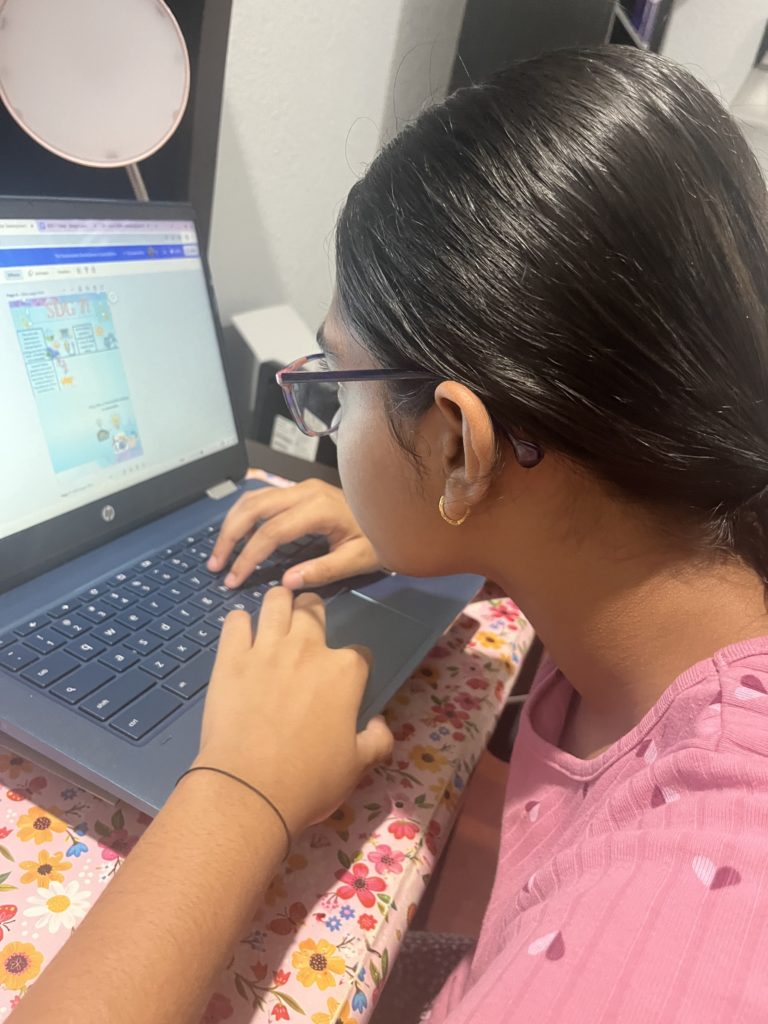
~Videos!~
Note: The medium used in this Energy Inspired Art Piece, was digital arts.

cool
Thank you!
I’m so glad you took some time, out of your day to look at my project, from last year! Hope you enjoyed it!
We need energy or else we cant play games, those are important, without them, I am forever bored.
Thank you! Yes, energy is definitely needed, in order to play video games!
I’m so glad you took some time, out of your day to look at my project, from last year! Hope you enjoyed it!
THIS. IS. AMAZING. What a process you went through! This is very well done.
Thank you Mrs. Trujillo! I appreciate your feedback!